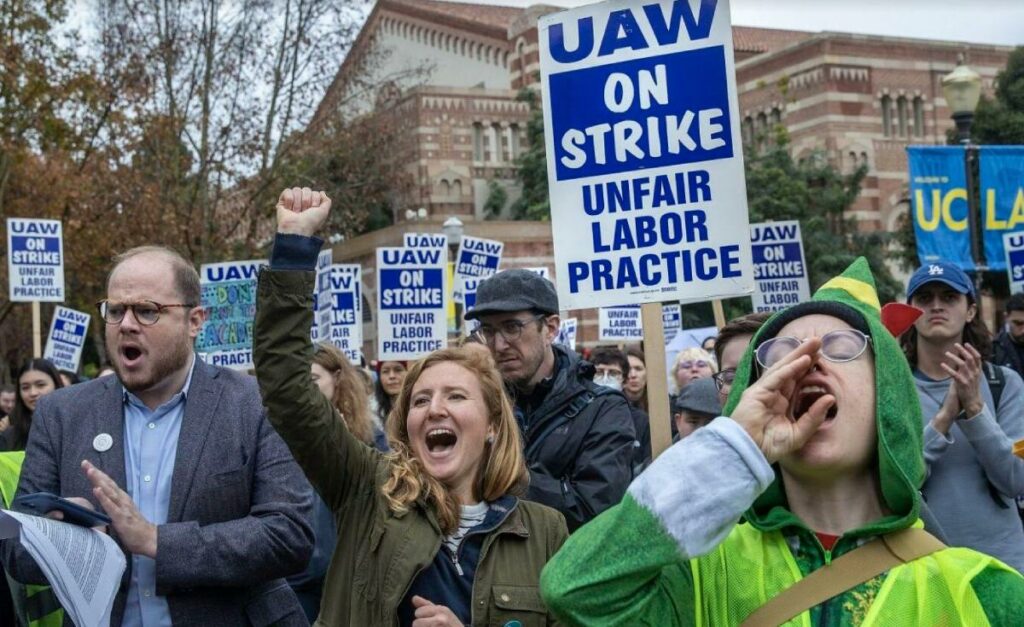
Passed in 1947, the Taft-Hartley Act restricts the activities and powers of labour unions in the United States. Photo credit: LA Times/Mel Melcon
In a recent essay for National Review, Dominic Pino examines conservatives’ opposition to unions since the union movement gained legislative heft in the 1930s. As Pino suggests, the negative consequences of unions remain little understood in the United States, the bulwark of global capitalism. Pino asserts that conservatives have stood against organized labour and in favour of right-to-work legislation for decades.
Thanks to Robert Taft and Ronald Reagan, writes Pino:
Unions no longer have (the) level of power in American society (they once did), a fact for which we have conservatives to thank. A moment that proved the government can, in fact, do something about a strike was when Ronald Reagan ordered the firing of illegally striking air-traffic controllers and their replacement with nonunion workers in 1981, and then salted the earth by decertifying the union.
The history of these developments deserves some retelling. Just after World War II ended the United States endured two long years of significant national strike action. With the election of a Republican Congress in 1946 the situation required redressing. The National Labor Relations Act of 1935 guaranteed the right of private sector workers to unionize, collectively bargain, and strike. Initially, the Act tried to bring some equity to the negotiations between labour and owners. Certain practices were defined as unfair and would not be allowed to continue.
Republicans in Congress did not like the law and challenged it in court. In 1937 the NLRA was ruled constitutional in NLRA v Jones & Laughlin Steel Corporation. The Taft-Hartley bill sought to restrict some of the rights this Act imposed and provided for states to pass right-to-work laws which essentially guaranteed an employee’s right to refuse to pay union dues or join a union.
For those of us with historical union roots within our families, or who have personally benefitted from union activity it may seem contradictory to speak against the collective action of labourers to improve life for working people. Perhaps, but I have heard and read many people opposing conventional thinking, especially when a matter tips too far in one direction, or becomes corrupted. Although it pains me to say it in a publicly written form, unions, in particular those who represent government sector workers, have become redundant, intrusive, and degraded. This explains why I found Pino’s article for NR chronicling the efforts of conservatives over the past 75 years to restrain the power of organized labour instructive.
Roosevelt’s passage of the NLRA signaled to workers that they were now a force unto themselves, (and for FDR, a new voting bloc he could add to his growing coalition). As President Biden said in 2021 at a Labour Day rally, “when Congress passed the 1935 Labor Relations Act, it didn’t just say you can have unions… It said that we, the government, should encourage unions.”
The wave of strikes that hit the United States in 1945 and 1946 put somewhere between two and four million workers on picket lines. This kind of disruption comes at a cost and for the Democratic Party, holders of the House of Representatives since 1930, it meant second place in the subsequent election as Republicans added 55 House seats and 12 more in the Senate, allowing them the opportunity of passing legislation that still ranks near the top of conservative governing accomplishments over the past several decades.
The two men who sponsored the bill, Senator Robert Taft of Ohio and Representative Fred Hartley of New Jersey hoped to roll back the worst of NLRA’s most troubling features. In summary, as Pino recites, Taft-Hartley undertook to:
- prohibit jurisdictional strikes (striking over the way work is assigned between unions);
- Secondary strikes (striking against companies that do business with companies that are being struck);
- Solidarity strikes (striking to support another union’s strike, or for some broader national concept like Black Lives Matter or Pride);
- Banned closed shops where only union members can be hired; and
- Permitted the passage of right-to-work laws
While President Truman vetoed Taft-Harley, with help from Democrats in the South, Congress overrode the veto, making the bill law. Taft faced re-election in 1950 but overcame efforts to defeat him, taking his case to voters and educating them about the impact of unbridled unionism on people’s daily lives. Later, in a sterling example of how unions work to destroy businesses, Pino recounts the story of how Walter Reuther of the UAW led a six-year strike against the Kohler Company of Wisconsin and its founder, Herbert Kohler Sr. Despite employing just about everybody in its namesake town with good quality and respectable paying jobs, Reuther wanted to unionize the company. Kohler refused, hired nonunion workers, and stood against a national boycott Reuther attempted to enforce. As Pino noted:
It is a truth independent of politics that the number of workers represented by a union will always be smaller than the number of people who could be affected by labor disruptions. Far more Americans depend on freight railroads for their livelihoods than work for the freight railroads; far more Americans use products that contain steel than work in the steel industry.
No greater example of the numerical imbalance occurred than in January 1966 in New York. As Pinot discussed, “…the transit workers went on strike for twelve days, shutting down all buses and trains. Millions of people couldn’t get to work on account of the actions of about 30,000 transit workers.” The transit strike was illegal, as was the aforementioned Air Traffic Controllers efforts in 1981 that President Reagan confronted. As William Buckley, founder of NR wrote in the magazine afterward, “Unions are entitled to special protections provided by specific law. But a violation by a union of the United States Code makes it organizationally delinquent and its civil protections derivatively inoperative.”
Taft-Hartley had restrained the union’s actions, something that does not seem possible in Great Britain, a nation that has endured transportation strikes the last two years and has a history of being immobilized when unions have decided to take action. As Pino points out, the United States, thanks to Taft-Hartley has been spared these kinds of debilitating work stoppages.
Pino completes his look at the important role of restraining unions with a quick overview of the right-to-work movement founded in 1955. Under the leadership of Reed Larson in the 1960s and 1970s, the group, officially titled National Right To Work Committee (NRTWC), ensured that politicians knew there were more than unions to consider when passing labour legislation. If not for the millions of people Larson signed up, the Johnson, Nixon, and Ford administrations would likely have passed laws allowing compulsory union membership.
As Mark Mix, the present president of the committee said, “We punched above our weight,” noting that unions always outspent them. Still, five new right-to-work laws have been enacted in the last 11 years and Mix argues that right-to-work states are measurably better off because:
- RTW legislation attracts new industries like car manufacturing plants
- Job growth is better in these states
- Welfare receipt and public-pension health superior
Unionization is down to 10.1 per cent in the United States, with only six per cent of private sectors belonging to a local, while a full third of public sector workers belong to one. Conservative efforts to address this problem have borne fruit. As Pino reported, “In the 2018 case Janus v. AFSCME, Samuel Alito wrote for the Court that no worker can be forced to subsidize a public-sector union unless he or she “affirmatively consents to pay.” Buckley best articulates why conservatives must remain vigilant in opposing union power, especially when working with the state.
He saw big business, big government, and big Labour as threats to self-government. Unions combined two of the three making it a more potent threat. Unions would like to interfere with independent business, they seek to reduce flexibility, and in effect diminish productivity. The ease of starting a business explains why America enjoys a high level of entrepreneurship compared to heavily unionized nations.
Pino closed his article with a quote from a 1965 Buckley column, “If it should stand, suddenly, as the party that seeks to woo the vote of organized labor at the expense of its highest principles of individual freedom, as incorporated into the Taft-Hartley Act, what role is there for the GOP except for the opportunists who want, occasionally, to alternate power with the Democrats?”
Conservatives need to continue to stand with those who value individual freedoms, including the right to work without coercion from unions who today seek to confiscate worker wages to promote progressive causes, accuse traditionalists of hate, and empower an oligarchy of labour titans.

Dave Redekop is a retired elementary resource teacher who worked part-time at the St. Catharines Courthouse as a Registrar until being appointed Executive Director at Redeemer Bible Church in October 2023. He has worked on political campaigns since high school and attended university in South Carolina for five years, earning a Master’s in American History with a specialization in Civil Rights. Dave loves reading biographies.




















